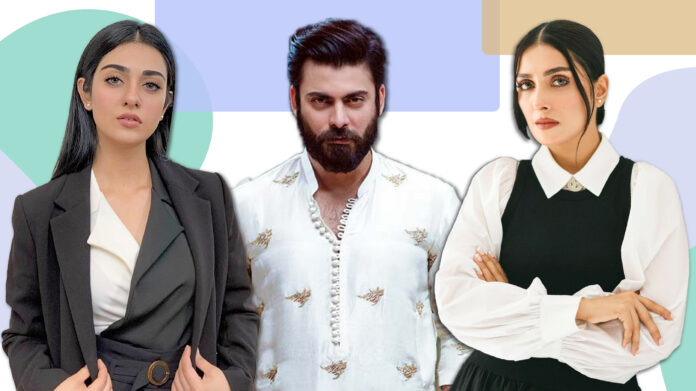The impact of styling decisions on a character’s persona in Pakistani dramas is nothing short of exponential. In our vibrant world of Pakistani dramas, where storytelling reigns supreme, it’s easy to overlook the transformative power of fashion. However, these style choices hold the potential to either define or diminish a character, leaving an indelible mark on the audience’s memory and turning them into icons that are remembered for years to come.
How can styling aid in building characters?
Styling can be a powerful tool that can be employed for various purposes and can undoubtedly aid in building an entire persona of a character. From building a stronger connection with the audience to symbolizing a time and era setting, in addition to helping with character development, good styling can go a long way.
Over the years our actors and directors have given us some memorable looks and have sketched a distinct style for their characters that has proven to be a significant element in making a character iconic.
Good and bad: Unforgettable wardrobe moments in Pakistani dramas over the years
Mahira Khan’s iconic look in the 2011 drama serial Humsafar, where she donned in a flowy black dress remains fans’ favourite till date. The dress is vintage and gained so much popularity more than a decade ago that hundreds, if not thousands, of fans, recreated the look. Ask a Pakistani drama fan and we are certain they can spot Khirad’s character in a moment of seeing Mahira’s picture in that black dress.
This was not the only time Mahira Khan’s wardrobe choice got recognition from the fans. In her last aired television project -as of now- Mahira hit it out of the park when it came to styling her character Mehreen in Hum Kahan Ke Sachay Thay. Her no-makeup makeup look, alongside her round pair of glasses, and loose braid, complimented Mehreen’s character and mirrored her personality.
Another iconic look from the past drama serial was Yumna Zaidi’s styling for Mahjabeen’s character in Pyar Ke Sadqay. Mahjabeen’s goofy personality was reflected not only through her body language, dialogues, and expressions but also her dungarees. Later her transformation, after marriage, was reflected also in her wardrobe i.e., to a more sophisticated style with subtle makeup, blow dried hair, and modish shalwar kameez.
In Ishq Zahe Naseeb, Yumna Zaidi once again created a remarkable character, Shakra, who was a maid in the house of the protagonist character and also his split personality. Shakra’s red pout, curly hair, and her signature red dubatta and black shalwar kameez, sent chills down the audience’s spine and added a layer of mystery in her character.
Another actress who captivated our attention with her fashion choices was Sarah Khan in the drama Sabaat. Although her character, Miraal, faced criticism for her stubborn and antagonistic role, her wardrobe choices were on point. They effectively conveyed the essence of a wealthy young woman and exuded a chic, contemporary, and trendy appeal.
Ayeza Khan has garnered consistent acclaim for her fashion selections. Her portrayal in Chupke Chupke will forever stand out, thanks to her distinctive hair clips, jeans, and loose kameez. Her styling departed from the usual on-screen conventions, crafting a distinctive and individualized look for her character. Furthermore, her appearance in Meray Paas Tum Ho received notable praise. The evolution of her character, transitioning from aspiring wealth, acquiring it and adjusting her attire accordingly, to her eventual downturn, was skillfully portrayed through her appearance. Furthermore, Ayeza Khan’s stunning appearance in a black saree also left a lasting impression.
However, Ayeza Khan’s recent styling in the drama Mein has received criticism from the audience. The clothes that have been shortlisted for the scenes are mismatched and fail to enhance her character.
Moving to the men and their fashion choices some actors have left us impressed over the years. In the drama, Main Abdul Qadir Hoon Fahad Mustafa not only aptly portrayed the evolution of his character, but his choice of outfits was on point for each phase of the character’s life shown.
Moreover, in the period play Dastaan, Fawad Khan’s wardrobe choice was immaculately decided. The outfits were appropriate according to the time period and also mirrored the mood of the drama. In addition, it made the character believable.
Naumaan Ijaz has time and again proven his acting skills. An element that has certainly played a pivotal role in shaping his roles are his outfits for each drama and the overall styling. A notable character that he played in the popular drama Sang-e-Mar Mar was Gulistan Khan. The character’s attire was in accordance with the Pashtun culture that was being highlighted in the drama.
Another memorable fashion moment that won the heart of not only the entire nation but also left its impact globally was Murtasim Khan’s shawl. You guessed it right. Wahaj Ali’s character Murtasim from Tere Bin will always be remembered-among many other reasons – for its iconic shawl. The fashion choice of adding a shawl left so much impact that shawls have made a return to men’s fashion in the country.
Costume Design Pitfalls in Pakistani Dramas
Unfortunately, there has been a noticeable lack of attention to costume design in our dramas. Firstly, there’s a prevalent uniformity in character appearances. Female characters typically sport blow-dried hair, standard shalwar kameez attire, and a consistent makeup style, making it challenging to distinguish between characters and appreciate the individual actors portraying them. Similarly, male protagonists often adhere to a familiar formula of gelled hair and mostly sporting stubble.
Moreover, the depiction of characters often strays from realism, with female characters frequently adorned in excessive makeup even during hospital scenes or emotionally charged moments.
Additionally, we frequently observe characters being styled according to stereotypes. Heroines and female leads are usually seen in traditional eastern attire, while wealthy antagonists tend to don western clothing. This stereotypical approach to dressing characters limits the diversity and authenticity in our dramas.
Internationally thoughtfully styled characters: the transformative power of fashion in television
Fashion in television can be a game-changer, turning characters into iconic figures. Internationally, we’ve witnessed numerous examples of characters becoming synonymous with their fashion choices. For instance, Rachel’s character from Friends remains iconic till date. Jennifer Aniston’s character not only influenced hairstyles but also inspired fans to emulate her outfits from casual to formal.
Moreover, the unconventional fashion showcased in The Devil Wears Prada garnered significant appreciation and set new trends in the fashion world.
Characters like Mike Ross and Harvey Specter from Suits redefined men’s fashion, leaving a lasting impact with their revolutionary styles.
Fashion is the unsung hero that often shapes characters in ways we might not immediately recognize. It’s the unspoken language that transcends words, conveying depths of personality and storytelling that leave an indelible mark. Actors have harnessed the transformative power of styling to not just play characters but to become them.
Yet, amid this sartorial marvel, there’s a call for evolution in the world of Pakistani costume design, an opportunity to break free from the mold and explore the diversity of character appearances. Thus, we urge not only the actors to put in more time and effort to style their characters but also hope that producers and directors comprehend the potential of this unexplored resource and harness its potential.




